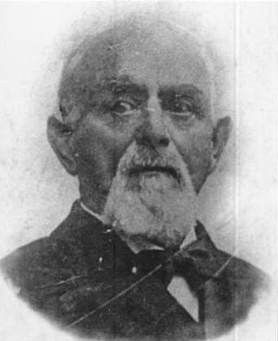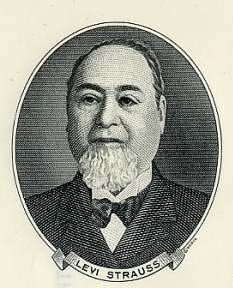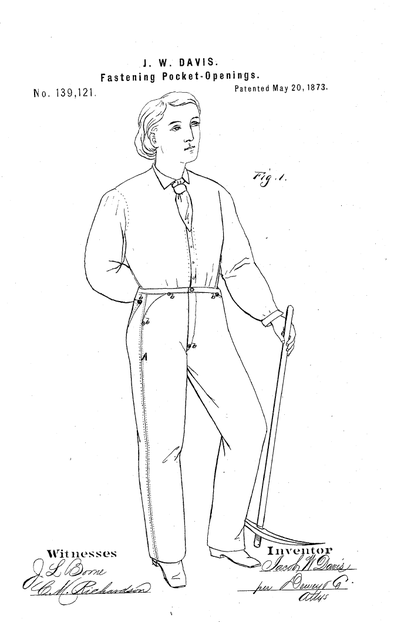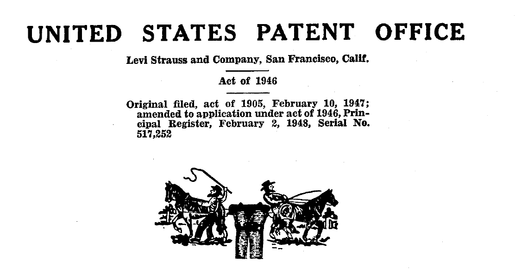 Jacob Davis
Jacob Davis
On May 20 of the year 1873, U.S. Patent No. 139, 121 issued to Jacob Davis of Reno, Nevada and was entitled an "Improvement in Fastening Pocket-Openings". The '121 patent covered "pantaloons" having pocket openings secured at each edge by rivets and was assigned to Davis and the Levi Strauss & Company of San Francisco, California, which was owned by Levi Strauss and his brother, Jonas. The use of rivets, in combination with denim, ushered in the age of the modern "blue jean" and helped make Levi Strauss & Company a household name.
Davis and the Strauss brothers were all immigrants. Davis came from Riga, Latvia, while the Strauss brothers came from Buttenheim, Bavaria. After moving around the U.S. and Canada for a number of years, Davis settled in Reno and opened a tailor shop, where he made tents, horse blankets and wagon covers, mainly for workers on the Central Pacific Railroad. Davis typically made these items from duck cloth (a type of canvas made of plain woven cotton) and used copper rivets to reinforce his stitches. Davis purchased his duck cloth from Levi Strauss & Company, which the Strauss brothers had started in San Francisco in 1853. At the time, Levi Strauss & Company were importers and wholesale distributors of domestic dry goods, including fabric, such as duck cloth and denim.
One day, the wife of a local woodcutter asked Davis if he could make a pair of sturdy work pants for her husband. This request gave Davis the idea of using rivets to secure some of the stitching in the pants, which he made from duck cloth. Since the stitching around the pockets was the most vulnerable from hands being constantly moved into and out of the pockets, Davis placed rivets at the edges of the pockets.
Word of Davis' new work pants or "waist overalls" quickly spread and soon Davis was indundated with orders for them. Realizing he had made a successful invention, Davis approached (Levi) Strauss and proposed that they form a partnership to patent his inventive waist overalls as well as to market and sell them. Strauss agreed, and made Davis a partner in Levi Strauss & Company. They also filed a patent application for Davis' invention, which issued as the '121 patent. The sole claim of the '121 patent was quite broad, reading: "As a new article of manufacture, a pair of pantaloons having the pocket-openings secured at each edge by means of rivets, substantially in the manner described and shown, whereby the seams at the points named are prevented from ripping, as set forth."
Not satisfied with the breadth of the '121 patent, Davis and Strauss obtained a reissue of their patent less than two years later. In the reissued patent (RE 6,335), they broadened their claim to read: "As a new article of manufacture, pantaloons or other garments having their pocket-openings secured at the edges by means of rivets, or their equivalents, substantially in the manner described and shown." (emphasis added)
 Levi Strauss
Levi Strauss
The popularity of the Davis waist overalls (now manufactured and sold by Levi Strauss & Company) took another leap forward when Strauss started making them out of denim, which caused much less chafing. With the popularity of the Levi Strauss waist overalls exploding, it was no surprise that competitors started making copies of them. Strauss successfully enforced his (reissued) patent against these competitors in several lawsuits, one of which was against a large Chicago-based clothing wholesaler and retailer called the the Henry W. King & Co. This lawsuit was particularly contentious and lasted almost two years. The Henry W. King & Co. defended itself on the grounds that the reissued patent was invalid for lack of invention, arguing that a rivet was equivalent to a stay of sewed thread, which had been used in the past. The court disagreed and found for Levi Strauss & Company.
Although Strauss was successful in enforcing his patent, he knew that he would need something else to keep his competitors at bay once the patent expired. And what he came up with was building a strong brand through advertising and marketing, as well as trademarks. The first trademark that was used was the famous Two Horse logo that was printed on a leather patch that was sewn into the rear of the waistband. The Two Horse logo was first used in 1886 and was registered as a trademark in 1906. Other trademarks followed, including "LEVI'S", which was registered in 1928.
Although Strauss was successful in enforcing his patent, he knew that he would need something else to keep his competitors at bay once the patent expired. And what he came up with was building a strong brand through advertising and marketing, as well as trademarks. The first trademark that was used was the famous Two Horse logo that was printed on a leather patch that was sewn into the rear of the waistband. The Two Horse logo was first used in 1886 and was registered as a trademark in 1906. Other trademarks followed, including "LEVI'S", which was registered in 1928.



